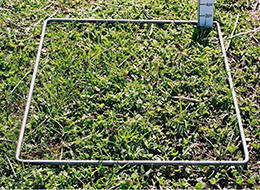After what was an early finish to last season, producers over the state have had their eyes to the sky waiting for rain and for the finish of what has been for many, a long period of supplementary feeding. In most districts good rainfall has occurred throughout May and resulted in good germinations, although feed on offer is still low in some areas which will have implications for lambing ewes and subsequent lamb growth rates.
Those people who used stock containment areas or sacrifice paddocks whilst supplementary feeding stock are now seeing the benefits from undertaking this management strategy. It has provided them with greater amounts of feed on offer now available for lambing ewes. Ideally, the minimum feed on offer required before putting stock onto pastures after the break of season is 500kg DM/ha. Delaying the entry of sheep back onto the paddocks up until to at least this amount allows an increase in leaf area index, which in turn speeds up the rate of pasture growth. The key now is to have paddocks stocked optimally for lambing to ensure that pasture growth rates throughout winter will keep up to the stock requirements.
Energy requirements to maintain a ewe in condition score 3 during late pregnancy and lactation ranges considerably depending on how many lambs the ewe is carrying/feeding, the day of pregnancy/lactation and the weight of the ewe. In general, the following pasture targets for Feed on Offer (FOO) will supply adequate requirements (from Lifetime Ewe Management):
|
500 kg/ha FOO Autumn |
1,000 kg/ha FOO Autumn | |
|
 |
|
Optimum lamb growth rates to weaning are achieved at these targets. At 1000kg DM/ha, lamb growth rates will fall to around 70% of the maximum rate. Additionally, lambs on legume based pastures will grow 20-30% faster than those on grass based pastures.
If you are not sure about what the above pasture targets look like, there is a feed on offer library which has photo standards of known pasture biomass and quality for typical pastures across the different seasons throughout Australia at http://www.feedonofferlibrary.com/
or the Pasture Photo gallery at Lifetime Wool website.
Good pasture management and nutrition of ewes during pregnancy and at the point of lambing is the most important factor affecting lamb survival during the first week of life. Increasing FOO from 500 to 1500 kg DM/ha will increase the survival of twin born lambs by 15-20%, regardless of birth weight.
Maintaining ewes in condition score 3 is a critical determinant of conception rates, placental development, foetal growth, wool follicle development (influencing both clean fleece weight and fibre diameter), udder development and milk production. At condition scores less than 3, ewe mortality can also be expected to increase.
Pregnancy scanning of ewes for twins and singles ensures that target requirements are met and feed sources can be allocated accordingly. Whilst it is essential not to underfeed twin bearing ewes, it is just as important not to over feed single bearing ewes. Ewe nutrition in the last month of pregnancy affects lamb birth weight and in singles overfeeding can lead to high birth weights causing dystocia (birth difficulties). Even lambs that are born alive after a difficult birth may survive for a couple of days, but due to brain trauma they may have an inability to suckle and die from starvation, or have bleeding in the brain causing death. Lambs that are too small will not have the body fat reserves to survive exposure to inclement weather conditions. Optimum lamb birth weight for survival is 4.5 – 6.0kg.
Having adequate feed on offer will also affect ewe maternal behaviour and colostrum production which will affect lamb survival, particularly in twins. Mob size at lambing is important in terms of ensuring optimum stocking rates for pasture production to meet nutritional requirements, but also to prevent the risk of mismothering if stocking densities are too high. The following recommended Lifetime Ewe Management targets for mob size are:
Single bearing ewes are reasonably bullet proof, so if you are short of pasture at lambing, ensure that the best FOO and sheltered paddocks are allocated to twin bearing ewes.
Further detail available from Elke Hocking Consulting - Mob 0427 667 081